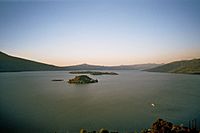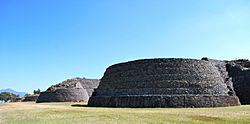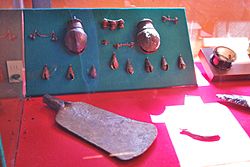Purépecha Empire facts for kids
Quick facts for kids
Purépecha Empire
Iréchikwa
|
|||||||
|---|---|---|---|---|---|---|---|
| c.1300–1530 | |||||||
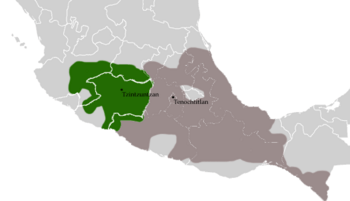 |
|||||||
| Capital | Tzintzuntzan | ||||||
| Common languages | Purépecha Tecuexe | ||||||
| Religion | Polytheism | ||||||
| Government | Monarchy | ||||||
| Cazonci | |||||||
|
• 1300–1350
|
Tariácuri (founder) | ||||||
|
• 1520–1530
|
Tangáxuan II (last) | ||||||
| History | |||||||
|
• Established
|
c.1300 | ||||||
| 1530 | |||||||
| Area | |||||||
| 1450 | 75,000 km2 (29,000 sq mi) | ||||||
| Population | |||||||
|
• 1519
|
1,500,000 | ||||||
|
|||||||
| Today part of | Mexico | ||||||
The Purépecha Empire, also known as Iréchikwa, was a powerful state in pre-Columbian Mexico. It covered much of what is now the Mexican state of Michoacán. It also included parts of Guanajuato, Guerrero, and Jalisco.
When the Spanish arrived, the Purépecha Empire was the second-largest state in Mesoamerica. It was a major rival of the Aztec Empire. The Purépecha Empire is sometimes called the Tarascan Empire. However, many Purépecha people do not like this name.
The empire started in the early 1300s. It lost its independence to the Spanish in 1530. Later, in 1543, it became a Spanish governorship called Michoacán. This name comes from the Nahuatl word Michhuahcān. It means "place of fishers."
The Purépecha Empire grew stronger over time. It was controlled by a ruler called the Irecha or Cazonci. The capital city was Tzintzuntzan. It was located by Lake Pátzcuaro. The first Cazonci, Tariácuri, founded the city. His family, the "Wakúsïcha" (meaning "Eagles"), ruled the empire.
The Purépecha Empire was a strong enemy of the Aztec Empire. They fought many wars. The Purépecha stopped the Aztecs from expanding to the northwest. They built forts and patrolled their borders. This made them one of the first true "territorial states" in Mesoamerica.
The Purépecha culture was unique in Mesoamerica. They were one of the few civilizations to use metal. They made tools and even weapons from metal.
Contents
What Does Purépecha Mean?
The word "Purépecha" comes from "P'orhépicha" in the Purépecha language. It means "commoner" or "everyday person." It refers to people going about their daily lives.
The name "Tarascan" comes from the Spanish word "Tarasco". This word came from "Tarhaskwa" in Purépecha. It means "parent-in-law" or "child-in-law." Some Purépecha people find this term offensive.
Who Lived in the Empire?
The Purépecha Empire included many different groups of people. The main group was the Purépecha people. Other groups included Matlazincas, Tecos, Mazahuas, Otomíes, Chontales, and Nahuas.
Over time, many of these groups became part of the larger Purépecha culture.
Where Was the Empire Located?
The Purépecha Empire was in a high volcanic area of Mexico. It was located between two large rivers: the Lerma and Balsas Rivers. The area had different climates, from warm to tropical. It had many volcanic mountains and lake basins.
The people mostly lived around the lake basins. These areas had many resources. In the north, near the Lerma river, there were obsidian deposits. Obsidian is a volcanic glass used for tools. The heart of the Iréchikwa was around Lake Pátzcuaro.
How Did the Empire Begin and Grow?
Long ago, the Purépecha area was home to early cultures. One well-known early culture was the Chupícuaro culture. Their sites were often on lake islands. This might connect them to later Purépecha traditions.
Most of what we know about the Purépecha Empire comes from a book. It is called the Relación de Michoacán. A priest named Fray Jeronimo de Acalá wrote it around 1540. He wrote down stories from Purépecha noblemen.
The Visionary Leader Tariácuri
Around Lake Pátzcuaro, different groups lived together. The Relación de Michoacán tells us about a leader named Tariácuri. He had a vision to unite the communities around Lake Pátzcuaro.
Around 1300, Tariácuri began to conquer nearby areas. He made his sons, Hiripan and Tangáxoan, rulers of Ihuatzio and Tzintzuntzan. Tariácuri himself ruled from Pátzcuari city. By the time Tariácuri died around 1350, his family controlled all the main centers around Lake Pátzcuaro.
Expanding the Empire
Tariácuri's son Hiripan continued to expand the empire. Later, his brother Tangáxuan I helped make the empire stronger. They set up a system where conquered areas paid tribute. They also created an administration to manage the empire.
The empire continued to grow. It reached the Pacific coast in 1460. It also expanded into the Toluca Valley and Guanajuato.
Wars with the Aztecs
The Purépecha Empire often fought with the Aztecs. In the 1470s, the Aztecs tried to take over Purépecha lands. But the Purépecha defeated them. This made the Purépecha ruler build more forts along the Aztec border. He also allowed other groups, like the Otomíes and Matlatzincas, to settle there. They helped defend the Purépecha lands.
From 1480, the Aztec ruler Ahuitzotl increased attacks. But the Purépecha, led by cazonci Zuangua, fought them off. The Purépecha expansion stopped until the Spanish arrived.
Between 1480 and 1510, the Purépecha took over parts of Colima and Jalisco. They wanted to control saltpeter mines there. Saltpeter was important for making things. The people in these areas fought back in the Saltpeter War. After 30 years, the Purépecha were forced to leave these areas.
Religion
Like many Mesoamerican cultures, the Purépecha worshipped many gods. Their main god was Curicaveri/Kurikaweri, the god of the sun.
Metalworking Skills
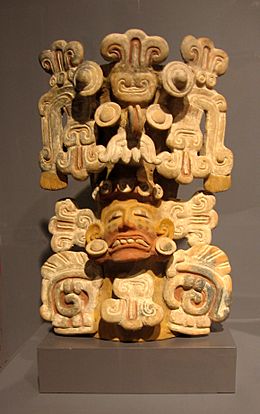
The Purépecha were very skilled at working with metals. They were among the best metalworkers in pre-Spanish Mexico. They used copper, silver, and gold. Michoacán had gold, Tamazula had silver, and La Huacana had copper.
They made many items from metal. These included shields, armlets, bracelets, and cups. They also made copper bells using a special method called lost-wax casting. These bells were used in religious ceremonies. Later, they made items from copper-gold and copper-silver, like discs and masks. They also made tools from bronze, such as needles, fishhooks, and axeheads.
Some people think the Purépecha learned metalworking from cultures in South America.
How the Empire Ended
When the Purépecha cazonci Tangáxuan II heard that the Aztec Empire had fallen, he sent people to meet the Spanish. Some Spaniards went to Tzintzuntzan. They met the ruler and exchanged gifts. The Spanish saw gold, and Hernán Cortés became interested in the Purépecha Empire.
In 1522, a Spanish force led by Cristóbal de Olid reached Tzintzuntzan. The Purépecha army was huge, possibly 100,000 soldiers. But they chose not to fight. Tangáxuan agreed to Spanish rule. He was allowed to keep much of his power.
For a few years, both Cortés and Tangáxuan saw themselves as rulers of Michoacán. The people paid tribute to both. But when the Spanish found out Tangáxuan was still largely in charge, they sent Nuño de Guzmán. He was a very harsh conquistador. He allied with a Purépecha noble, Don Pedro Panza Cuinierángari.
On February 14, 1530, the cazonci Tangáxuan II was executed. This started a period of violence. The Spanish put puppet rulers in place. But later, Bishop Vasco de Quiroga was sent to fix things. He earned the respect of the native people. This helped bring peace to the area under Spanish rule.
Images for kids
-
Chakmul. Cultures of the West Chamber. National Museum of Anthropology (Mexico)
See also
 In Spanish: Imperio purépecha para niños
In Spanish: Imperio purépecha para niños



